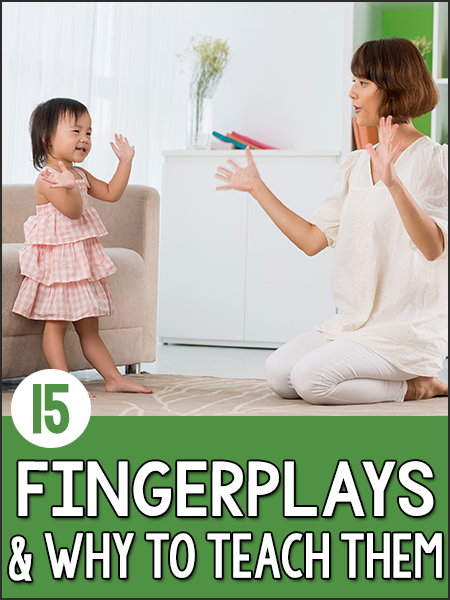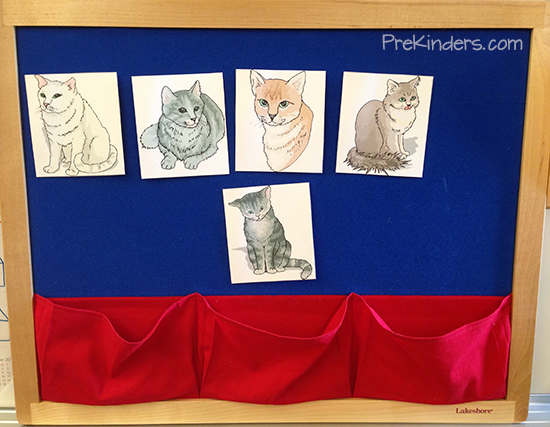Today, I’m joining Teach Preschool and Pre-K Pages to bring you 15 Fabulous Fingerplays and Facts. Here at PreKinders, I am sharing 5 fingerplays and 5 facts about the skills children learn through fingerplays. Be sure to go to Teach Preschool and Pre-K Pages to see the rest!

Fingerplay Fact #1: Building Vocabulary
Fingerplays introduce children to new words to increase their vocabulary. They help children connect vocabulary to words they hear in stories and in every day conversation. They also help children learn sentence structure and practice speaking in complete sentences. An example of a fingerplay rich with new vocabulary is Wee Willie Winkie. This is a traditional nursery rhyme that becomes a fingerplay when you add movements to it. There are many nursery rhymes you can add movements to and most of these teach new vocabulary.
Some children may not know the word “town” because they may not have heard it used before — maybe they’ve heard the word city, but not town, so it would be a word that could be discussed with the rhyme. Most children will have a different understanding of the word, “rapping”. By having them pretend to knock while saying the word rapping, they will learn that words can have more than one meaning. The word “crying” or “cry” is a word often seen in children’s books to mean “call”. Often children are confused by the use of “cry” in a story because they haven’t yet learned that it can have another meaning.
Wee Willie Winkie
Wee Willie Winkie
Place your hand low to the ground to pantomime a short person
Runs through the town
Pretend to run in place
Upstairs and downstairs
Point up, point down
In his nightgown
Smooth hands down over your clothes to indicate what he’s wearing
Rapping at the window
Pretend to knock
And crying through the lock
Hold hands at mouth and pretend to call out the next line
“Are the children all in bed?
For now it’s 8 o’clock.”
Point to wrist as though you are pointing to a watch (or point to classroom clock)
Fingerplay Fact #2: Number Concepts
There are numerous fingerplays that teach number concepts. Some rhymes add one with each line of the poem, other rhymes take one away with each line. Rhymes and fingerplays teach counting forward and backward, addition and subtraction. They teach children to recite numbers in order, recognize numerals, tell what number comes before and after a number. With many rhymes you can print out clipart to go with the rhyme and place them on a magnet board or flannel board (e.g. five rabbits to go with Five Little Bunnies, five pumpkins for Five Little Pumpkins, or five monkeys for Five Little Monkeys). My prekinders also like to recite the rhyme, Five Little Monkeys Jumping on the Bed, and instead of putting monkeys on a flannel board, five children get to jump on our pretend “bed” (our group carpet).
Bee Hive
Here is the bee hive.
Cup hands together
Where are the bees?
Peek into “hive”
Hidden away where nobody sees.
Hide “hive” behind back
Watch and you’ll see them come out of the hive.
Bring “hive” back out front
1…2…3…4…5…BUZZ!
Open fingers one by one.

Fingerplay Fact #3: Following Directions
Fingerplays teach children to listen carefully and follow directions. When fingerplays are recited, children have to pay attention and listen so they know what to do next.
Teddy Bear, Teddy Bear
Teddy bear, teddy bear, turn around.
Teddy bear, teddy bear, touch the ground.
Teddy bear, teddy bear, jump up high.
Teddy bear, teddy bear, touch the sky.
Teddy bear, teddy bear, touch your nose.
Teddy bear, teddy bear, touch your toes.
Teddy bear, teddy bear, hop around.
Teddy bear, teddy bear, sit on the ground.
Fingerplay Fact #4: Position Words and Directionality
Many fingerplays help children learn position words and directional language, such as on, over, above, under, around, etc. Teddy Bear, Teddy Bear (above) is one example of this. This turtle fingerplay also uses the direction words “in” and “out”, and is a favorite with my prekinders.
This is my turtle.
Make fist, extend thumb
He lives in a shell.
Hide thumb in fist
He likes his home very well.
He pokes his head out when he wants to eat.
Poke thumb out of fist
And pulls it back in when he wants to sleep.
Pull thumb back into fist
Fingerplay Fact #5: Social-Emotional Development
Fingerplays can build children’s social-emotional development by helping children see themselves as a member of a group. They help children gain confidence in their abilities. In the rhyme, Monkey See, Monkey Do, children have a turn to think of a movement for the whole group to do. Each child sees that their classmates acted out their own idea. Demonstrate this several times yourself over several days before asking children to think of movement words.
Monkey see, monkey do,
I can wiggle
How about you?
The rhyme is short and simple enough that children can learn quickly and recite for the group. Then, the group does the movement that child said. For children who are shy, the teacher can say the rhyme along with them, or the child could whisper the movement into the teacher’s ear and the teacher would recite the rhyme with their word.

